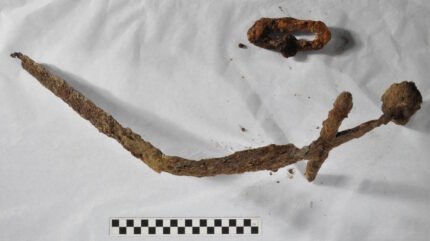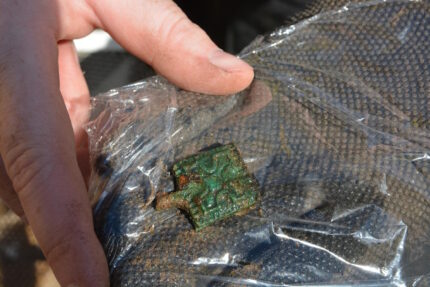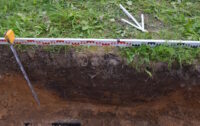 A crusader-era sword discovered this summer in Salo-Pertteli, southwest Finland, led to the discovery of a previously unknown cemetery from the same period. The sword and has a straight crossbar hilt with a three-sided oval pommel. The type dates to ca. 1050-1150.
A crusader-era sword discovered this summer in Salo-Pertteli, southwest Finland, led to the discovery of a previously unknown cemetery from the same period. The sword and has a straight crossbar hilt with a three-sided oval pommel. The type dates to ca. 1050-1150.
The sword was discovered by a local landowner in late August of this year. He spied a piece of an iron object jutting out of the soil of a geothermal pipe trench after heavy rains. When he pulled it out, he saw it was an almost complete sword. He contacted Juha Ruohose, an archaeology professor at the University of Turku who in turn alerted Sanna Saunaluoma, the archaeologist at the Turku Museum Center who is the official in charge of archaeological material for the Salo area.
 Saunaluoma inspected the find site the next day, and suspected that the sword was probably not a single random object that had made its way to the pipe trench. Ruohonen and a team of students from Turku University explored the discovery site in early September to find out more about the sword’s context. They unearthed additional blade fragments, a piece of the scabbard, iron objects of yet-to-be-determined nature, and the remains of a leather belt adorned with thirty square bronze pendants decorated with rosette patterns and several cross-shaped pendants. The belt’s parts also include a buckle, end tips, animal head decorations and strap dividers. A knife hung from the belt. The knife was not found, but its leather sheath decorated with bronze rings was. Fragments of the leather from the belt managed to survive as well, as did remnants of fabric.
Saunaluoma inspected the find site the next day, and suspected that the sword was probably not a single random object that had made its way to the pipe trench. Ruohonen and a team of students from Turku University explored the discovery site in early September to find out more about the sword’s context. They unearthed additional blade fragments, a piece of the scabbard, iron objects of yet-to-be-determined nature, and the remains of a leather belt adorned with thirty square bronze pendants decorated with rosette patterns and several cross-shaped pendants. The belt’s parts also include a buckle, end tips, animal head decorations and strap dividers. A knife hung from the belt. The knife was not found, but its leather sheath decorated with bronze rings was. Fragments of the leather from the belt managed to survive as well, as did remnants of fabric.
 Buried with all these objects were human bones and pieces of wood that may have been coffin parts. The materials are all elements from a single burial. The complete belt and the textile fragments are particularly rare.
Buried with all these objects were human bones and pieces of wood that may have been coffin parts. The materials are all elements from a single burial. The complete belt and the textile fragments are particularly rare.
The excavation expanded outward from the sword find site to reveal a larger cemetery. Eight graves were unearthed just from the walls of the pipe trench, and archaeologists estimate the cemetery had dozens more graves, perhaps as many as 200.
Ruohonen says that the discovery can be considered very significant from a research point of view, as far fewer cemeteries containing inhumations from the time of the Crusades are known in Finland than earlier Iron Age cremation grave sites. The deceased in this newly-discovered cemetery were buried in accordance with Christian customs.
“The location of the site, in the immediate vicinity of a medieval stone church, can be considered as evidence of a much earlier church organization in the area than previously believed. It has been thought that Pertteli parish was established with the founding of the Uskela chapel in the 15th century,” Ruohonen points out.
Radiocarbon dating is being carried out on the bone recovered from the site. The belt and a knife sheath are being x-rayed, further studied and conserved.